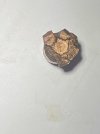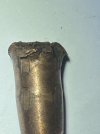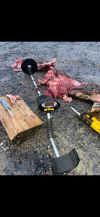Gday
This is a reply I said I'd do from my last post on lrh on @frako21 thread
Sorry for the delay as had some major flooding to deal with in my local area
Hopefully this info is taken from a constructive position & will allow us all to learn a little bit more & what mark ( @mcdil ) does with it is solely upto him
My tests always cover as many possibilities from varying angles +low,med&high resistances with many velocity impacts that will potentially occur in the field for whom I do tests for
MY RESULTS: I'm not going to suger coat it as a failed shank is exactly that failed ! To me others may have a different view which is cool but please read on
I got other results that were more in line of what one would expect but the velocity window is way less than I assumed it would be by a big margin & so glad I tested these pills for a young fella prior to him heading out on a trip of a lifetime
The pill was the 135 afterburner shot from a 11 twist 300 rum @ approx 3810 MV ( I did get to 4053 but backed off as I have for a lot of my tests lately)
Pill rpm should be just shy of 250 k ( please check)
Velocity impacts ranged from 2730-3755
The 2 highest impacts ( resistance & velocity) 3605&3755 were complete & utter failures imo , the 3600 shank fractured while I believe the 3750 shank disintegrated As I can't put anything else into the equation as all I could find was a 8 gr piece the tip & heaps of small fragments / flakes & no exits both had extremely shallow penertration not making it into the chest cavity ( both we're shoulder joint shots on the knuckle as I call it )
while I believe the 3750 shank disintegrated As I can't put anything else into the equation as all I could find was a 8 gr piece the tip & heaps of small fragments / flakes & no exits both had extremely shallow penertration not making it into the chest cavity ( both we're shoulder joint shots on the knuckle as I call it )
The next velocity impacts were around 3020&3080 which preformed better terminally & the shank held together ( resistance was medium) showing some interesting things to me
 but I'll see how far @Petey308 come before I open my mouth & please I'm not trying to be smart I'm seeing how far he has come to hopefully help him gain knowledge for his book also others please chime in if you've seen similar looking things
but I'll see how far @Petey308 come before I open my mouth & please I'm not trying to be smart I'm seeing how far he has come to hopefully help him gain knowledge for his book also others please chime in if you've seen similar looking things
The impacts below 2900 I only found one petal & few fragments & terminal damage was extensive on low resistance
As always if I'm wrong on the way I've gone about things & anyone can relay the error in what /how I do things by all means tell me but please let's keep it civil & out of the gutter
cheers
Ps I've tried organising pictures but this muppet is having trouble & it will only allow me to add 10 so here's a few more I hope






This is a reply I said I'd do from my last post on lrh on @frako21 thread
Sorry for the delay as had some major flooding to deal with in my local area
Hopefully this info is taken from a constructive position & will allow us all to learn a little bit more & what mark ( @mcdil ) does with it is solely upto him
My tests always cover as many possibilities from varying angles +low,med&high resistances with many velocity impacts that will potentially occur in the field for whom I do tests for
MY RESULTS: I'm not going to suger coat it as a failed shank is exactly that failed ! To me others may have a different view which is cool but please read on
I got other results that were more in line of what one would expect but the velocity window is way less than I assumed it would be by a big margin & so glad I tested these pills for a young fella prior to him heading out on a trip of a lifetime
The pill was the 135 afterburner shot from a 11 twist 300 rum @ approx 3810 MV ( I did get to 4053 but backed off as I have for a lot of my tests lately)
Pill rpm should be just shy of 250 k ( please check)
Velocity impacts ranged from 2730-3755
The 2 highest impacts ( resistance & velocity) 3605&3755 were complete & utter failures imo , the 3600 shank fractured
 while I believe the 3750 shank disintegrated As I can't put anything else into the equation as all I could find was a 8 gr piece the tip & heaps of small fragments / flakes & no exits both had extremely shallow penertration not making it into the chest cavity ( both we're shoulder joint shots on the knuckle as I call it )
while I believe the 3750 shank disintegrated As I can't put anything else into the equation as all I could find was a 8 gr piece the tip & heaps of small fragments / flakes & no exits both had extremely shallow penertration not making it into the chest cavity ( both we're shoulder joint shots on the knuckle as I call it )The next velocity impacts were around 3020&3080 which preformed better terminally & the shank held together ( resistance was medium) showing some interesting things to me

 but I'll see how far @Petey308 come before I open my mouth & please I'm not trying to be smart I'm seeing how far he has come to hopefully help him gain knowledge for his book also others please chime in if you've seen similar looking things
but I'll see how far @Petey308 come before I open my mouth & please I'm not trying to be smart I'm seeing how far he has come to hopefully help him gain knowledge for his book also others please chime in if you've seen similar looking thingsThe impacts below 2900 I only found one petal & few fragments & terminal damage was extensive on low resistance
As always if I'm wrong on the way I've gone about things & anyone can relay the error in what /how I do things by all means tell me but please let's keep it civil & out of the gutter
cheers
Ps I've tried organising pictures but this muppet is having trouble & it will only allow me to add 10 so here's a few more I hope







